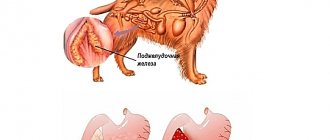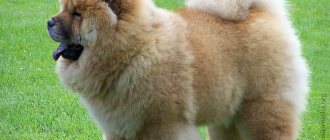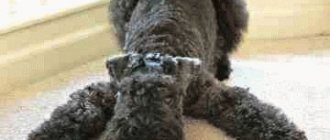Exterior and external differences
In the Molosser group, which includes the Rottweiler, sexual dimorphism is extremely developed. This means that a typical male dog differs from a female dog in the same way that a lion differs from a lioness.
Males
The head is the leading shape in the breed, so the differences primarily relate to its size and outline. A male with a mediocre head loses all its showiness, while a high-browed, voluminous head in the skull, with well-developed cheekbones and a wide pincer is the hallmark of a high-breed dog.
Compared to a female, males are heavier (50-60 kg), taller (61-68 cm), have strong bones (metacarpus girth 15-16.5 cm), powerful necks and well-defined withers. Their body is more compact, their muscle mass is larger, their skin is thicker, and their fur is coarser. Males develop much longer, becoming fully loaded and fully formed only by the age of 3 years. An adult, seasoned male invariably attracts the eye, creating the impression of remarkable strength, masculinity and fearlessness. They say about such people with admiration: “Machine!”
Selected male dogs in the Champions ring are bright representatives of the breed and its ideal, and male dogs with a rating of at least “excellent” are allowed for breeding. In addition to malocclusion, partial teeth and cryptorchidism, disqualifying defects are small bones, flakiness and effeminateness. At the same time, the true value of a breeding sire lies in its prepotency, i.e. genetic strength and the ability, when mating with different bitches, to produce offspring not lower than their level.
Thus, male dogs are chosen by lovers of large size, colorful masculine energy and those who want to challenge the title of “best of the best” in the show ring.
Bitches
Most bitches have a head outlined with soft smooth lines, more elongated and not so spacious between the ears. It’s great if the “lady” has a prominent and beautiful head with a pronounced transition from the forehead to the muzzle, but even so, its outlines are quite distinguishable from the large and heavy head of a male dog.
Bitches are usually smaller in size (height at the withers 56-63 cm), lighter (weight 40-47 kg) and thinner in bone. Their body is more stretched due to the long chest and lower back, which is explained by the physiological need to bear numerous offspring. The skin of bitches is thinner and more elastic, the coat is softer, and the muscles are drier.
It is not so rare to find large and bony “bears” (the so-called “bitches of the male type”), not inferior to the male half of the dog either in height or in the volume of the chest. However, this type, despite its impressiveness, is not welcomed by judges and experienced breeders, since according to the breed standard, gender must be clearly expressed. Thus, a physically developed Rottweiler breed is a fusion of sensitivity, strength and energy.
According to the rules of the Federation Cynologique Internationale (FCI), bitches with a rating of at least “very good” are allowed for breeding - in other words, they are forgiven for minor exterior defects. However, with the right selection of a pair, a good breeding dam gives birth to puppies of the highest class, thus becoming an improver of the breed.
"The basic Instinct"
In addition to external differences, when choosing a representative of one sex or another, the characteristics of physiology and behavior associated with reproduction become decisive.
Males
Young males reach sexual maturity at approximately 8 months, after which they can mate with any female of suitable size. In the philistine environment, there is an opinion that a “boy” should not be allowed into mating before the age of 2, which supposedly slows down his growth. In fact, size is determined by genetics, however, a dog may be significantly shortened in height if it is poorly fed and poorly cared for.
Males of large breeds from 18 months of age are allowed for breeding in the FCI system. However, this does not mean that any dog is worthy of leaving offspring. The need for breeding a male dog is exaggerated by owners who are far from cynology and identify dogs with people.
Let us only note the fact that in a pack of wolves only the leader and the dominant female are mated, and all other individuals perform the function of hunters, nannies and bodyguards. Based on the objectives of purebred breeding, only a chic standard male can be allowed to breed, while dogs with defects in appearance and psyche must be content with the life of a pet.
The brightness of the sexual instinct is determined by heredity, personal temperament, age and constitution: heavy, obese, phlegmatic and elderly male dogs may not be at all interested in the “fair sex”.
However, the most typical “male” behavior is year-round readiness to mate. And if you do not pay enough attention to targeted physical activity and training, the dog will be driven solely by “basic instinct”, which determines such undesirable traits of testosterone-driven behavior as a tendency to run away, disobedience and aggression.
A specific feature of sexually mature males is also the desire to meticulously sniff and mark with urine all places that stand out in appearance and smell. The act of urination of a male dog is stimulated by the smell of a female dog in heat, which an amazing dog’s nose can smell from 2 kilometers away! If the Rottweiler is not accustomed to obedience, and the owner is not an ironclad authority for him, then the entire walk will be reduced to running from tree to tree to constantly mark the territory and persistently search for the “lady of the heart.” There are often cases when, having caught the exciting aroma, the temperamental “groom” got out of the enclosure in the most intricate way, made a dig or jumped over the fence.
Bitches
The reproductive function of bitches is perhaps the determining factor in choosing a puppy. Rottweilers are very prolific and give birth to an average of 8-10 puppies. Litters of 15 or more newborns are known, but sometimes there are only 1 to 5 babies.
The first estrus usually occurs at the age of 8-10 months and repeats on average every six months. Some bitches have 3 heats per year, and sometimes the period between cycles is 8-9 months. The duration of estrus is about three weeks, however, the so-called “estrus” occurs in the second half and is observed in different bitches from 9 to 18 days. At the same time, the previously bloody discharge lightens, becoming pinkish or straw-colored, and the swollen and enlarged genital loop becomes soft and pliable. Most often, “fertile days” are 12-16, so even a single mating during this period implies the conception of numerous offspring.
The odorous substances (pheromones) released by a female dog in heat are very attractive to male dogs of all breeds, sizes and colors. That is why you can see how yard dogs are on duty at the gate of the house where the Rottweiler in heat lives day and night. A bitch in heat demonstrates her readiness for mating: she whines, flirts with the “suitors” and freezes in an eloquent pose, raising her tail invitingly. Some “brides” are so loving that they can run away from the owner after the dog they like. That is why bitches in heat should be walked exclusively on a leash, and for the entire period of heat they should be safely hidden in an enclosure or kept in the house.
Needless to say, unplanned mating with a mongrel is extremely undesirable, especially if it happens during the first heat. The body of a young female, which has not reached physiological maturity and is forced to bear and give birth to puppies, is subjected to significant stress - and therefore breeders who love their dogs do not recommend allowing a bitch to give birth before the age of 2 years.
A good nursery is inconceivable without strong breeding stock, so the bitch is chosen by those who are engaged in breeding work. It is also suitable for those who like to play with furry, four-legged children. However, prioritizing making a profit from a dog by selling puppies is not only unethical, but also risky, since anything can happen during childbirth, and raising a decent litter is an art.
It is very rare that descendants are better than their parents, so worthy format females should be selected for the tribe, passing on to their children all the wealth of the gene pool. In turn, the mating of rootless non-conforming dogs that produce the same puppies is a crime against the breed.
Bitches
Advantages:
- More gentle, flexible and calm.
- They are more obedient and affectionate with their owner, and gravitate more toward the home.
- They're smarter. The intelligence of bitches is higher, and their emotional perception of the external environment is subtler and more complex.
- Bitches are more cunning, so they give fewer reasons for punishment.
- Easier to train.
- West Terrier females are not inclined to show aggression towards either males or females.
- It's easier to take part in breeding. It is enough to have one exhibition rating.
- During a walk, they only need to sit down once or twice and they can go home. But this does not mean that you can’t walk with a bitch a little! The bitch should get long, full walks. It’s just that when your time is very limited, walking with females is faster and more convenient.
Flaws:
- Bitches are less elegant and usually smaller than males.
- Once every six months or a year, the female dog comes into heat. During this period, she becomes less obedient and may smell stronger. If the bitch does not lick itself, then you will have to buy special panties for dogs.
- During estrus, female dogs are not allowed to go out hunting together with male dogs.
Important: if you are not going to use the bitch for breeding, then it would be more correct to sterilize her after 7-8 years. Thus, the risk of cancer is significantly reduced.
Psychological characteristics and working qualities
Rottweilers of different sexes also have their own psychological characteristics, which is reflected in the specifics of training approaches and working use.
Males
The “men” of the dog world are straightforward, assertive and stubborn, but at the same time they are open and stereotypical. In this regard, training a male dog should begin as early as possible (from 4 months of age), using an integrated approach to training and ensuring strict execution of commands. Considering the fact that Rottweiler boys grow very quickly and reach a weight of 40 kg by six months, it is very important to develop a calm and adequate attitude of the teenager towards everything around him (to undergo the so-called “socialization”), and also to instill in him “rules of good manners” in relation to with people.
Polishing the initial skills and repeating them in new, more difficult conditions makes it possible to achieve unquestioning obedience to such a powerful and large dog. In particular, a male dog must master the forbidden word “No!” well, work with restraint and at a distance without a leash, which makes the dog easily controllable with the help of his voice.
During the obedience course, the most dominant individuals can show character and disobedience, and sometimes aggression, directed at both people and animals. That is why male dogs should be dealt with long and hard, preferably under the supervision of an experienced dog handler who not only has reciprocal determination and sufficient physical strength, but also knows the rules of behavior in a conflict situation. A male who has mastered the required requirements, thanks to a strong, balanced psyche, will work stably and confidently, regardless of the conditions and complex of stimuli.
But one should not think that Rottweiler obedience is achieved solely through drill and harsh physical force. The recipes of the “experienced” ones, which tell us that a dog must invariably be “broken” by beating, smack of zoosadism and an inferiority complex. Yes, the Rottweiler, as a service dog, is capable of entering into confrontation with a person, but at the same time he is endowed with the intelligence of a 6-year-old child, human dependence and the desire to work for his beloved owner. This is why contact in the “man-dog” tandem is so important in the training process, and everything else is just a consequence of such interaction.
In protection training, male dogs have a slight advantage over female dogs due to their size, physical strength and natural aggressiveness. In addition, a male dog can be used year-round as a service, guard and sports dog, which cannot be said about female dogs due to their sexual cycles and motherhood function.
Bitches
Bitches are usually softer in character, less prone to leadership and more compliant, but at the same time they are emotional, cunning and insightful. At the initial stages of training, they grasp new things faster than males, but in an unusual environment or under the influence of strong stimuli they can work unstably. There are few real dominants among them, but there are plenty of stubborn and wayward ones. Having received rebuff or reprimand, the bitch retreats for a while. But only in order to find a suitable loophole, a different method of influence and an alternative way to achieve what you want.
In protection classes, female Rottweilers with the breed's temperament are distinguished by their extraordinary performance and perseverance, and their lack of strength and weight compared to males is more than compensated for by speed, agility and tirelessness. Due to their sensitivity, intelligence and plasticity, “girls” are better suited for trick training. You can successfully work with them even in such complex types of canine sports as freestyle (“dancing with dogs”).
In the guard craft, representatives of the “fair sex” are more sensitive, excitable and therefore react faster to external stimuli. Thanks to these mental properties, bitches do an excellent job of protective guard duty. Unlike male dogs, they are not concerned with “basic instinct” (except for days in heat) and therefore are reputed to be conscientious and incorruptible guards. A bitch who is in the heat stage becomes disobedient, flirts with male dogs and is not very keen on fulfilling her work duties.
In a relatively large area, to increase efficiency, it is recommended to keep a pair of guard Rottweilers: an energetic, temperamental female and a strong, assertive male. A seasoned male who knows his business usually does not waste energy in vain, while the female reacts to any suspicious sound or movement. If the danger is real, then a male “tank” hurries to help her friend.
If it is decided to use a working bitch for procreation, then, starting from the second month of pregnancy, physical and psychological stress is reduced, excluding strength training, jumping and swimming in natural reservoirs (the latter to avoid the introduction of infections into the genital tract). In the final period of pregnancy and in the first 3-4 weeks of feeding puppies, the mother is completely exempt from sports training and security work.
Male/bitch at home
In addition to their function as guards and bodyguards, Rottweilers are often kept as companion dogs and pets. You can keep them both in a house (apartment) and in the yard by equipping a good-quality enclosure with a warm booth.
Males
The male illustrates the slogan: “The Rottweiler is a dog of one owner.” This means that, even living in a family, he will be unconditionally devoted to only one person, considering him his master and god. Usually the real head of the family claims this role - after all, dogs instinctively smell the leader. The male will communicate with all other “members of the pack” as the hierarchy allows. That is why it is important that the whole family participates in raising and training a pet, going through all aspects of “canine science” with it.
You should also take into account the fact that the “stronger sex” needs to be walked vigorously and for a long time, taking into account the specific physiology and allowing the dog to completely empty its bladder. As you know, the male does not do this right away, instinctively “dosing” urine to place scent marks throughout the territory.
Thus, the minimum walk should be 20 minutes, otherwise stagnation of urine will occur, fraught with cystitis and stone deposition. To release energy and get physical training, you need an active walk for an hour, and the same amount of time needs to be devoted to obedience classes. No matter how sweet and affectionate a baby Rottie may seem, neglecting his training is frivolous, because without instilling decent rules of behavior, the dog is guided solely by its animal instincts.
When kept in a private house or enclosure, walking is necessary not so much to satisfy natural needs (the dog can also relieve its needs in the yard), but for socialization. A Rottweiler who has never left the gate does not know how to behave in the “big world”, which is fraught with serious psychological problems.
In particular, unbridled anger can mask self-doubt and the inability of the nervous system to respond adequately to a rapidly changing environment. An unsocialized dog is prone to fights with relatives and is aggressive towards strangers, while well-mannered males are balanced and calm. They bark little, and when kept in apartments, they simply sleep all day, waiting for the owner to arrive.
Some of the problem is that mature male dogs can have a strong "dog" odor, especially noticeable when the animal gets wet. However, with the help of regular brushing and bathing, this can be dealt with by teaching your pet to hygiene procedures from childhood.
Taking into account all the nuances of the Rottweiler’s character, a person who is strong enough in spirit and body will enjoy communicating with a male dog, while a softer nature should opt for a bitch or a representative of another breed.
Two adult male dogs can live quite peacefully in the same house, provided there is a sufficient difference in age and the authority of the owner. But even peers, in the course of several fights, quickly figure out the balance of power and subsequently maintain the established hierarchical order. Serious male fights usually occur in kennels when male dogs are forced to share the owner's attention, territory and female dogs.
Bitches
Fans of bitches call them affectionate, homely and clean. Both physically and psychologically, it is much easier to deal with females, and in training they are more understanding and obedient. Due to their high sociality, bitches recognize the authority of all family members and, obeying the maternal instinct, treat children well, replacing them with both a watchman and a nanny.
Thus, a family with a small child is highly recommended to buy a female puppy. At the same time, dog handlers do not advise leaving unattended even the most patient dog or an unintelligent child who is not yet able to understand the rules of handling an animal.
Walking the bitch can, if absolutely necessary, be kept to a minimum: the “girls” do “their business” quite quickly, and only during the period of heat they tend to place tempting scent marks for the “grooms”. Short walks should alternate with full ones, because Rottweilers love running with their relatives, fetching, jumping and playing with equipment (ball, puller, liker).
The owner’s task is to direct the pupil’s energy in the right direction, otherwise she will turn into a real hooligan, causing a real pogrom in the yard and in the house.
It is quite acceptable to walk a bitch who has completed an obedience course without a leash, but not during her heat, since the “bride” may well disregard all the previously learned “rules of good manners.” For bitches kept in an apartment (in a house), the time of heat is also marked by the ubiquitous red spots and droplets, which is doubly inconvenient if the “princess” is allowed to climb onto the sofa and bed. To maintain cleanliness, it is recommended to limit the location of the bitch in heat (one room, a corridor or a large cage), or put on her special sanitary panties with pads, sold in pet stores.
Two “ladies” can be kept in the same territory, especially if the younger one was raised by the older one from puppyhood. Bitches who dislike each other demonstrate a notorious vindictiveness, and on occasion they will fight again and again, inflicting serious wounds.
Why do you need a dog?
The first question you must answer for yourself when you want to buy a four-legged friend is “Why do I need a dog?” Yes, now we will dissuade you from deciding to get a puppy.
First of all, read “25 Points Why” by Galina Isakova.
You will live without days off. This cycle will never end. You will never relax. A walk awaits you in the morning and evening. All year round and even on the morning of January 1st. You will not be able to go on business trips or vacations. Life will turn into two events: Walking and Feeding. Walk. Feed. Walk. Feed. Walk.
Although it is written in a humorous manner, it is true.
Dogs are owned by those who want to be loved. Cats are adopted by those who are ready to love themselves. The hamster has a different task in the spirit of Jesus Christ - to show children death.
- Think twice if you are squeamish .
You just need to know about some of the nuances of living together.
- Puppies pee and poop whenever they want and wherever they want to.
- During shedding, dog hair is absolutely everywhere and, as one dog lover said, “you open a new stick of butter and there’s hair there.” Representatives of some breeds shed their fur constantly.
- Those dogs whose coat is similar to that of a German Shepherd can emit a strong “dog smell” when wet.
- Short-faced representatives of breeds such as Bulldogs, Pugs often snore in their sleep. They're drooling.
- They also fart, often at the most inopportune moments.
- After walks, the dog’s paws need to be washed, otherwise there will be dust and dirt in your house all the time.
- Keeping a four-legged pet requires a lot of time. They need to be walked with some breeds, such as Doberman, Husky, at least 2 hours a day !
- In the modern world, owning a dog is quite expensive. Even little ones who eat a couple of tablespoons a day. Because good food is expensive, and cheap food often leads to diseases in pets. Yes, dogs get sick (surprisingly, even in our age, some people believe that a dog does not catch a cold and does not have problems with the gastrointestinal tract). And treating them is EXPENSIVE.
- Of course, there were cases when, let’s say the husband was against the dog, but the wife got one, after some time the head of the family loved and cared for the pet more than anyone else. But often, discord and frequent quarrels come to the family along with the puppy. Reproaches: “You promised that there would be no hair”, “You said that the breed does not bark”, “A puddle again! The carpet is ruined!” and so on, will be permanent.
- If you like to sleep and be at home, get a cat. You won’t need to walk with her in the rain, or go out in -30 in winter. You will have to walk at least 2 times a day, morning and evening. Even when the elevator does not work, even on the morning of January 1, for 10-15 years. An exception would be small dogs (Chihuahuas), which are trained to do their business while in a diaper.
- First of all, you must clearly understand that all the difficulties that may arise with the appearance of a dog in the house will fall on your shoulders. Even a 15-17 year old teenager will not be able to independently treat a dog if necessary, pay for vaccinations, care, and food. If you are not ready for this or hope that the child will cope on his own, getting a dog will be a mistake.











